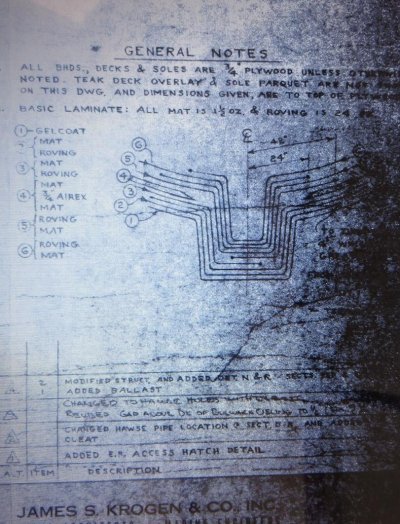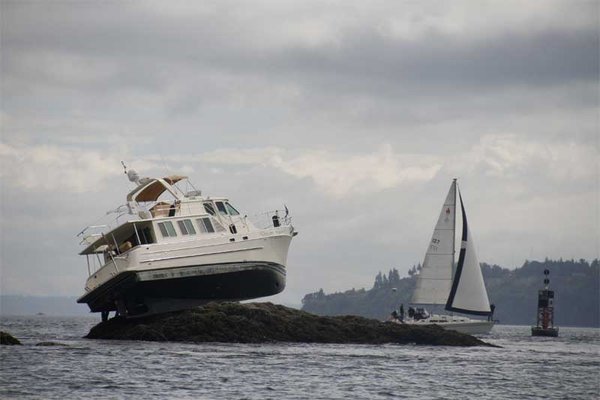Wxx3
Dauntless Award
- Joined
- Jan 10, 2013
- Messages
- 2,820
- Location
- USA
- Vessel Name
- Dauntless
- Vessel Make
- Kadey Krogen 42 - 148
I posted the below with pictures and a bit more on my blog, but it is simply too difficult to upload pictures to TF with crappy Wi-Fi.
Dauntlessatsea.com
Cored and Solid Fiberglass Hulls
Knowing almost nothing about fiberglass, other than it’s made of fiber + glass, I have been talking to Gary Mooney, the GRP (fiberglass) expert of the area who has been working on Dauntless this winter and has a lifetime of experience with it on boats and all sorts of other objects.
We’ve talked about the repairs he made on Dauntless, first there were two problems in the hull:
1. The four-foot-long hairline crack that I put in the hull the past July in Finland.
2. An older, badly repaired, thru-hull fitting, also in the forward bilge, that was haphazardly done and allowed water into the hull and was the source of the water in the amidships-forward compartment bulkhead.
So this got us talking about the Krogen hull, in particular, which is a cored, also called sandwich, hull:
1. there is a layer of fiberglass,
2. then the core, in this case, a white non-water absorbing Styrofoam like stuff,
3. then another layer of fiberglass.
4. This is then covered by a gelcoat layer, making the fiberglass impervious to water.
5. Then a two-part epoxy coat is put on to protect the gel coat, Dauntless gets two coats of that,
6. A “Tie-coat” comes next, this tie-coat allows the anti-foul paint to adhere to the epoxy,
7. And lastly comes the anti-foul coating. I am going to try a semi-hard coating, purposely made for very slow boats like Dauntless. It’s said to last 5 years and be smooth enough to slightly reduce fuel consumption. I’ll be happy if it lasts three years and doesn’t hurt fuel consumption.
This boat yard really caters to the commercial boats, so things like the anti-foul, are all things the fishing boats and trawlers (real ones) use and like.
So, talking of hulls with Gary, I asked him about solid fiberglass hulls.
It’s clearly touted in the USA as a “better” meaning safer solution. He scoffed at that, saying that most of the fishing boats here use solid hulls to make them stronger in terms of cargo and heavy equipment, but it also makes them more fragile.
A cored hull has much more flexibility, thus I could hit a rock as I did and the hull flexed enough to crack both the inner and outer layers of fiberglass. Had the hull been solid fiberglass, it’s likely it would have broken in big chunks leaving a meter-long hole in the hull.
This happened recently to a FV just off the coast. Had they not been minutes from shore, they would have sunk. I on the other hand, carried on for another 3 months totally oblivious!
A reliable source tells me that Jim Krogen was always a proponent of the cored hull (sandwich construction) and only succumbed to public perception in the mid-90’s when they changed to making solid fiberglass hulls, below the waterline. Besides better shear strength (as my encounter with the rock showed), a cored hull also provides better acoustical and thermal insulation, when compared to solid fiberglass.
This past winter, sitting outside in the wind and rain, Dauntless was dry as a bone inside, while many other boats with solid hulls, had condensation running off the walls forming little lakes. My storm windows also helped in that regard.
Dauntless was no. 148 in the 42-foot series and was made in 1988. Newer isn’t always better.
Our hull above the rub rail to the cap rail, the gunnel, also has sandwich or cored construction, but in this case, the core is much thicker, made of blocks of balsa wood and has an inner and outer wall for added strength.
Also, cored hulls do provide additional buoyancy, if nothing else, slowing the sinking.
Dauntlessatsea.com
Cored and Solid Fiberglass Hulls
Knowing almost nothing about fiberglass, other than it’s made of fiber + glass, I have been talking to Gary Mooney, the GRP (fiberglass) expert of the area who has been working on Dauntless this winter and has a lifetime of experience with it on boats and all sorts of other objects.
We’ve talked about the repairs he made on Dauntless, first there were two problems in the hull:
1. The four-foot-long hairline crack that I put in the hull the past July in Finland.
2. An older, badly repaired, thru-hull fitting, also in the forward bilge, that was haphazardly done and allowed water into the hull and was the source of the water in the amidships-forward compartment bulkhead.
So this got us talking about the Krogen hull, in particular, which is a cored, also called sandwich, hull:
1. there is a layer of fiberglass,
2. then the core, in this case, a white non-water absorbing Styrofoam like stuff,
3. then another layer of fiberglass.
4. This is then covered by a gelcoat layer, making the fiberglass impervious to water.
5. Then a two-part epoxy coat is put on to protect the gel coat, Dauntless gets two coats of that,
6. A “Tie-coat” comes next, this tie-coat allows the anti-foul paint to adhere to the epoxy,
7. And lastly comes the anti-foul coating. I am going to try a semi-hard coating, purposely made for very slow boats like Dauntless. It’s said to last 5 years and be smooth enough to slightly reduce fuel consumption. I’ll be happy if it lasts three years and doesn’t hurt fuel consumption.
This boat yard really caters to the commercial boats, so things like the anti-foul, are all things the fishing boats and trawlers (real ones) use and like.
So, talking of hulls with Gary, I asked him about solid fiberglass hulls.
It’s clearly touted in the USA as a “better” meaning safer solution. He scoffed at that, saying that most of the fishing boats here use solid hulls to make them stronger in terms of cargo and heavy equipment, but it also makes them more fragile.
A cored hull has much more flexibility, thus I could hit a rock as I did and the hull flexed enough to crack both the inner and outer layers of fiberglass. Had the hull been solid fiberglass, it’s likely it would have broken in big chunks leaving a meter-long hole in the hull.
This happened recently to a FV just off the coast. Had they not been minutes from shore, they would have sunk. I on the other hand, carried on for another 3 months totally oblivious!

A reliable source tells me that Jim Krogen was always a proponent of the cored hull (sandwich construction) and only succumbed to public perception in the mid-90’s when they changed to making solid fiberglass hulls, below the waterline. Besides better shear strength (as my encounter with the rock showed), a cored hull also provides better acoustical and thermal insulation, when compared to solid fiberglass.
This past winter, sitting outside in the wind and rain, Dauntless was dry as a bone inside, while many other boats with solid hulls, had condensation running off the walls forming little lakes. My storm windows also helped in that regard.
Dauntless was no. 148 in the 42-foot series and was made in 1988. Newer isn’t always better.
Our hull above the rub rail to the cap rail, the gunnel, also has sandwich or cored construction, but in this case, the core is much thicker, made of blocks of balsa wood and has an inner and outer wall for added strength.
Also, cored hulls do provide additional buoyancy, if nothing else, slowing the sinking.





